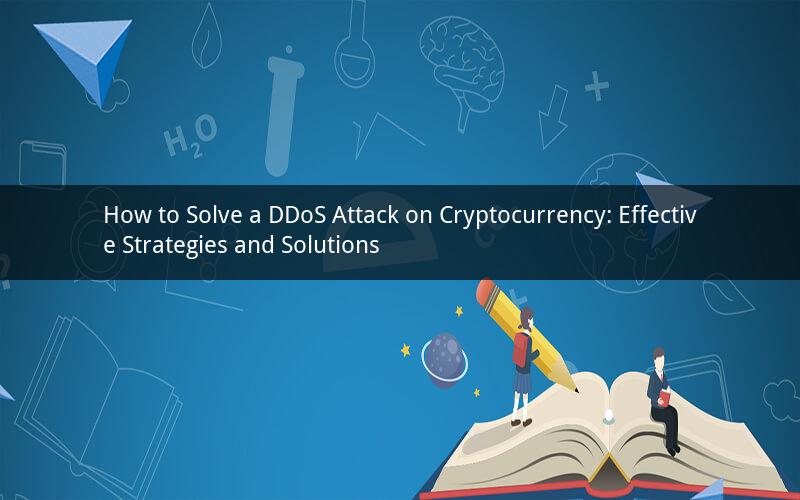
Introduction:
As the popularity of cryptocurrencies continues to rise, so does the number of cyber attacks targeting these digital assets. One of the most prevalent threats is a Distributed Denial of Service (DDoS) attack, which aims to disrupt the normal functioning of a cryptocurrency platform or network. In this article, we will explore various effective strategies and solutions to combat DDoS attacks on cryptocurrency.
1. Understanding DDoS Attacks on Cryptocurrency:
A DDoS attack on cryptocurrency involves overwhelming a target system or network with a flood of traffic, rendering it inaccessible to legitimate users. These attacks can be launched through various methods, such as botnets, reflection amplification, or application layer attacks. Understanding the nature of these attacks is crucial in implementing effective countermeasures.
2. Network Security and Infrastructure:
To protect against DDoS attacks, it is essential to have a robust network security and infrastructure in place. Here are some key steps to consider:
a. Implement firewalls and intrusion detection systems (IDS) to monitor and filter incoming traffic.
b. Utilize load balancers to distribute traffic evenly across multiple servers, reducing the impact of an attack.
c. Regularly update and patch your systems to prevent vulnerabilities that can be exploited by attackers.
d. Employ strong encryption protocols to secure sensitive data and communications.
3. Traffic Filtering and Rate Limiting:
One of the most effective ways to mitigate DDoS attacks is by implementing traffic filtering and rate limiting measures. Here's how you can do it:
a. Use a Web Application Firewall (WAF) to identify and block malicious traffic patterns.
b. Implement rate limiting to restrict the number of requests a user can make within a specific timeframe.
c. Utilize Content Delivery Networks (CDNs) to cache and deliver content, reducing the load on your servers.
d. Deploy IP reputation systems to identify and block known malicious IP addresses.
4. Cloud-Based DDoS Protection Services:
Cloud-based DDoS protection services can provide an additional layer of defense against attacks. These services can help you:
a. Identify and block DDoS attacks in real-time.
b. Scale your infrastructure to handle increased traffic during an attack.
c. Offer 24/7 monitoring and support to ensure your system remains protected.
5. Incident Response Plan:
Having an incident response plan is crucial in effectively handling a DDoS attack. Here are some key steps to include in your plan:
a. Establish a dedicated incident response team to handle the attack.
b. Document the attack and gather evidence for analysis.
c. Identify and isolate affected systems to prevent further damage.
d. Coordinate with relevant stakeholders, such as law enforcement or cloud providers, for support.
6. Educate and Train Employees:
Human error can often lead to vulnerabilities in a system. It is essential to educate and train your employees on best practices for cybersecurity. Here are some tips:
a. Conduct regular cybersecurity training sessions for employees.
b. Implement strong password policies and enforce multi-factor authentication.
c. Encourage employees to report suspicious activities or potential security breaches.
d. Stay updated on the latest cybersecurity threats and trends.
7. Legal and Regulatory Compliance:
Ensure that your cryptocurrency platform complies with relevant legal and regulatory requirements. This includes:
a. Implementing data protection and privacy measures.
b. Adhering to anti-money laundering (AML) and know your customer (KYC) regulations.
c. Regularly conducting security audits and vulnerability assessments.
Conclusion:
DDoS attacks on cryptocurrency can be devastating, but with the right strategies and solutions in place, you can effectively mitigate their impact. By implementing robust network security, traffic filtering, cloud-based protection services, and incident response plans, you can safeguard your cryptocurrency platform from DDoS attacks. Remember to educate and train your employees and comply with legal and regulatory requirements to ensure the overall security of your system.
Questions and Answers:
1. What is a DDoS attack?
A DDoS attack is a cyber attack where the attacker attempts to overwhelm a target system or network with a flood of traffic, rendering it inaccessible to legitimate users.
2. How can I protect my cryptocurrency platform from DDoS attacks?
To protect your cryptocurrency platform from DDoS attacks, you can implement network security measures, traffic filtering, rate limiting, cloud-based protection services, and an incident response plan.
3. What is the role of a Web Application Firewall (WAF) in DDoS protection?
A WAF can identify and block malicious traffic patterns, providing an additional layer of defense against DDoS attacks by filtering incoming traffic.
4. How can I educate and train my employees on cybersecurity best practices?
You can conduct regular cybersecurity training sessions, implement strong password policies, enforce multi-factor authentication, and encourage employees to report suspicious activities.
5. What legal and regulatory requirements should my cryptocurrency platform comply with?
Your cryptocurrency platform should comply with data protection and privacy measures, anti-money laundering (AML) regulations, and know your customer (KYC) requirements. Regular security audits and vulnerability assessments are also essential.